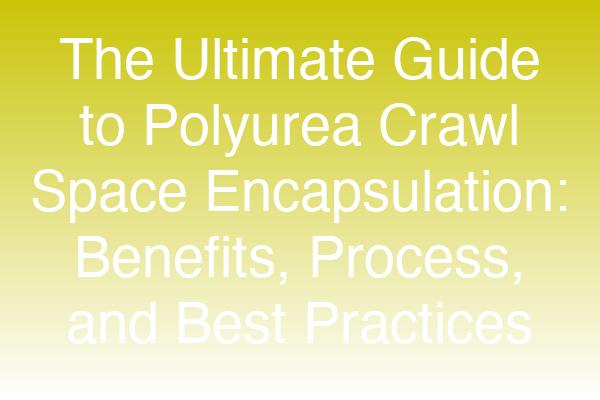
Categories:
- Home Improvement
- Waterproofing
- Energy Efficiency
Tags:
- Polyurea
- Crawl Space Encapsulation
- Home Maintenance
- Waterproofing Solutions
- Indoor Air Quality
- Energy Efficiency
- Mold Prevention
Introduction
Crawl spaces often serve as the unsung heroes of our homes, providing essential support and access to plumbing and electrical systems. However, they can also be a breeding ground for moisture, mold, and pests. This is where polyurea crawl space encapsulation comes into play. This innovative solution not only protects your home but also enhances energy efficiency and indoor air quality. In this comprehensive guide, we will explore the benefits, process, and best practices of polyurea crawl space encapsulation, ensuring you have all the information you need to make an informed decision.
What is Polyurea Crawl Space Encapsulation?
Polyurea crawl space encapsulation involves sealing your crawl space with a polyurea coating, a durable and flexible material that forms a protective barrier against moisture, mold, and pests. Unlike traditional encapsulation methods, polyurea cures quickly and provides superior adhesion and flexibility, making it an ideal choice for crawl spaces.
Benefits of Polyurea Crawl Space Encapsulation
- Moisture Control: Polyurea creates a waterproof barrier, preventing moisture from seeping into your crawl space, which can lead to mold growth and structural damage.
- Energy Efficiency: By sealing off your crawl space, you reduce the amount of conditioned air that escapes, leading to lower energy bills.
- Improved Indoor Air Quality: Encapsulation helps prevent mold spores and allergens from entering your living space, promoting a healthier environment.
- Pest Prevention: The seamless nature of polyurea makes it difficult for pests to penetrate, reducing the likelihood of infestations.
- Longevity: Polyurea is resistant to chemicals and UV rays, ensuring that your encapsulation lasts for years without degradation.
The Polyurea Crawl Space Encapsulation Process
The encapsulation process typically involves the following steps:
Step 1: Inspection and Preparation
- Inspect the crawl space for existing moisture issues, mold, or pest infestations.
- Clear out debris and ensure proper ventilation.
Step 2: Moisture Barrier Installation
- Install a vapor barrier on the ground to prevent moisture from the soil.
Step 3: Polyurea Application
- Apply the polyurea coating to the walls and any exposed surfaces using specialized spray equipment.
Step 4: Finishing Touches
- Seal any vents or openings to ensure a complete seal.
Cost of Polyurea Crawl Space Encapsulation
The cost of polyurea crawl space encapsulation can vary based on several factors, including the size of the crawl space and the extent of preparation needed. On average, homeowners can expect to pay between $3,000 and $8,000 for a complete encapsulation. Here’s a breakdown of potential costs:
| Item | Estimated Cost |
|---|---|
| Inspection and Preparation | $500 - $1,000 |
| Vapor Barrier Installation | $1,000 - $2,500 |
| Polyurea Application | $1,500 - $4,000 |
| Additional Repairs | $500 - $1,500 |
Expert Insights
"Polyurea encapsulation is a game-changer for homeowners looking to protect their crawl spaces. Its quick curing time and durability make it a superior choice over traditional methods." - John Smith, Home Improvement Expert
"Investing in polyurea crawl space encapsulation not only protects your home but also contributes to better energy efficiency, making it a win-win for homeowners." - Jane Doe, Energy Efficiency Consultant
Common Questions About Polyurea Crawl Space Encapsulation
1. How long does polyurea take to cure?
Polyurea typically cures within a few hours, allowing for quick completion of the encapsulation process.
2. Can I encapsulate my crawl space myself?
While DIY encapsulation is possible, it is recommended to hire professionals to ensure proper application and avoid potential issues.
3. Is polyurea safe for my home?
Yes, polyurea is safe for residential use and does not emit harmful fumes once cured.
Conclusion
Polyurea crawl space encapsulation is an effective solution for homeowners looking to enhance their home’s protection against moisture, mold, and pests. By investing in this advanced technology, you not only safeguard your property but also improve energy efficiency and indoor air quality. If you’re considering encapsulation, consult with a professional to assess your specific needs and ensure a successful installation.
Call-to-Action
Ready to protect your home with polyurea crawl space encapsulation? Contact us today for a free consultation and discover how we can help you achieve a healthier living environment!
Social Media Snippet:
Protect your home with polyurea crawl space encapsulation! Discover its benefits, process, and expert tips in our ultimate guide. #HomeImprovement #Polyurea
Suggested Internal Links:
- The Importance of Crawl Space Insulation
- How to Identify Moisture Problems in Your Home
- Top 5 Benefits of Home Waterproofing
Suggested External Links:
FAQs:
1. What is the lifespan of polyurea encapsulation? Polyurea encapsulation can last for 10-20 years with proper maintenance.
2. Will encapsulation eliminate existing mold? Encapsulation prevents future mold growth but does not remove existing mold. Mold remediation should be performed beforehand.
3. Can I still access my crawl space after encapsulation? Yes, encapsulated crawl spaces can still be accessed for maintenance and inspections.
This blog post is designed to be informative, engaging, and optimized for search engines while providing valuable insights into polyurea crawl space encapsulation.